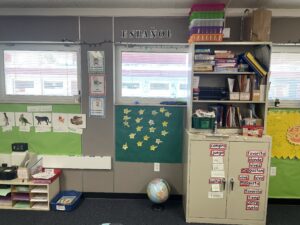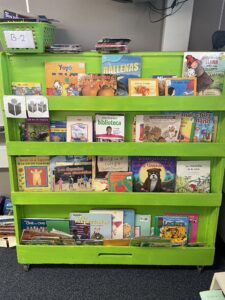Adaptations – Teaching in the 2020-2021 School Year, Part 1: CLASSROOM SET UP
As all of us are aware, ADAPT has forcibly become the modus operandi of the 2020-2021 school year. We are all teaching and interacting and planning in ways we never could have imagined just one year ago. And yet we’re DOING IT. Way to go, everyone!
As Dual Language Educators, we have unique added challenges to our adaptations. In many cases we are teaching language over the computer, whether for a portion of the day or all of it. Our practices and strategies have had to – you guessed it – adapt to these new ways of teaching and learning, and we essentially had to make those changes overnight. Now that we are in the depths of this ever-changing school year, we’ve had some time to wrap our heads around how to adapt in ways that benefit our students’ learning, health, and safety.
The reality of my situation may be different from yours, but perhaps some of the things my teaching partner, Bebi, and I have done may help you in your own unique situation as dual language educators. And PLEASE, I would love to hear your ideas and adaptations around teaching for biliteracy in various modalities!
OUR STORY
Elementary families in our school district were given the choice of either full distance learning or full in-person learning (five days a week) for their children. If a student tests positive or has symptoms of COVID, or if someone in their immediate family tests positive, they are automatically triggered to distance learning for 10-14 days or more, depending on symptoms. If a teacher tests positive, the entire class that teacher services is automatically excluded and put on the distance learning platform temporarily (this includes specialists, such as the music teacher and librarian, which could, in turn, effect quite a few classes, if not the whole school).
We felt it was extremely important that ALL students in the dual language program, whether in-person learners, distance-learners, or excluded for health and safety, have the right to continue their bilingual education. As a result, the dual language teachers stepped up to the plate of doing what’s best for our students. We’re doing it all.
Every day, our classes have both in-person learners and distance learners. The distance leaners log on to our virtual meeting and an iPad is set up so that they can see the rest of the class. The number of distance learners we have on a daily basis varies because it includes those students who are regular distance learners and those who are excluded temporarily for health reasons. One of the benefits of having this system is that those students who have the sniffles but are well enough to participate can still be a part of class from home! There is very little loss of instructional time. We even had a student who had to leave town for a family emergency, and he was on the Zoom call in the car as they drove. Now THAT’S adapting!!
I could write for days about all the adjustments we had to make in order to accommodate our ever-changing student population (and we continue to make even halfway through the year!!). However, I will break it down to a few tangible adaptations that hopefully will help you in your situation, and post one each week over the next several weeks.
1. Classroom setup
2. Organization: Planning, Papers, and People
3. Tech and Teaching Flexibility
4. Patience
CLASSROOM SETUP
One of the biggest changes we had to confront this year was in our classroom spaces. I work in a two-teacher model. Typically, there is a Spanish classroom and an English classroom, and Bebi and I share our students. I teach first grade in the morning while she teaches kindergarten, then the students switch rooms halfway through the day as the language of instruction changes. Well, ALMOST all of that remains the same this year. However, to reduce the number of shared surfaces, materials, and cross-contamination, it is Bebi and I, the teachers, who switch this year, not the students.
WOAH. We had a hard time wrapping our heads around this at first. What about my stuff? What about my word wall? What about my books??
Well…what about the kids?
It turns out, having the teachers do the switching is better for our students. There is less time lost in transitioning (which is now taken up by handwashing and cleaning tables, but hey – at least we aren’t searching for lost gloves!), and as Bebi and I quickly switch to set up our laptops in the other classroom at transition time, kids have time to work in their bilingual journals, our distance learners have a moment to get up and wiggle, and everyone has a brain break to adjust from English to Spanish or vice versa. I have to admit, it is working so well that we will likely keep this configuration post-pandemic.
At the beginning of the year, this classroom set-up was a serious switch and an important conversation between the two of us. Bebi said it this way:
“We used to be co-parents. Now we’ve moved in together!”
It is so true. I had to make space in “my” classroom for her, and she did the same for me. We spent time just sitting in the space together (socially distanced, of course!). We had to adjust from having only two linguistic spaces (Spanish and Bridge in her room, English and the Bridge in my room) to all three linguistic spaces in both rooms: Spanish, English, and the Bridge. Now our rooms would not be defined as The English Room or The Spanish Room, but instead The First Grade Room and The Kindergarten Room. The rooms are operating as a one-teacher model but with two different (masked) faces leading them.
We literally gave each other tours of the classroom. Extra colored pencils and crayons are here, the staplers are here, this open spot is for you to put materials for centers, Bandaids are in this drawer….
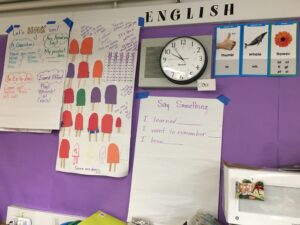
Here is the English wall, note the purple background as we have green for Spanish and purple for English.
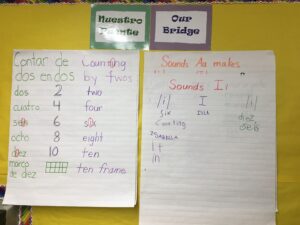
…and here is the Bridge wall! All three linguistic spaces are in both classrooms: Spanish, English, The Bridge.
We also decided that the kidney table in
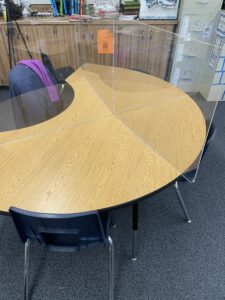
The kidney table, complete with plexiglass dividers, sits clean and ready for whoever needs to use it!
each room would be our proverbial shared bathroom, meaning LEAVE IT
CLEAN so the next person can use it. It has improved both of our piling tendencies tremendously!
BOOKS
One of the issues we are still working on is how to get books in the hands of our students. In the past, we each had a classroom library where kids could browse and choose books for free time reading or for their book bags. Seeing as how our classroom libraries are off-limits this year (at least for anyone to touch at their free will), we had a talk about what our kids need the most and how they could safely access the literature.
In our situation, most of our students have regular exposure to books in English. Our librarian pushes into the classroom once a week and everyone can choose a book or two from her cart to take home (most books offered are in English). Plus, our students attend a school with only one strand of Dual Language, so while we added bilingual signage to the school last year, it isn’t on every poster or on every sign. There’s English everywhere outside of our classroom.
All our students need more exposure to books in Spanish. Therefore, the display library in each classroom is filled only with books in Spanish this year. Students do get to access the Spanish books on the library display, just not like they used to (picture a crowded mob, some with a book in each hand, sharing texts, and returning at their free will). Bebi makes sure that they use hand sanitizer before and after choosing a book to read, and only two students are allowed at the library at a time.
This decision of a Spanish-only library means my awesome English-medium books on each biliteracy unit that I have meticulously collected over the years are kept tucked away on the shelf until I use them for a read aloud or pull one for a specific student need.
This doesn’t mean that our kids never see books in English. Every other week I set out new books – yes, teacher-picked but still thematic and enough that they have some choices – at each of their spots so that they can fill their book bags with fresh books. They can then turn in the old ones that get quarantined until the next round of books. They have books at their fingertips in both languages, but as we work to elevate the value of Spanish in our society, we have chosen to display only books in Spanish during this anything-but-normal year of teaching and learning.
TABLES and CUBBIES and CARPET SPOTS, oh my!
In order to make room for social distancing, our classrooms had to be purged of a lot of excess furniture. My unit bins are now in the shed at home and extra supplies are in the garage. We still have tables for our students, but each one has a 4-partitioned plexiglass set up so students don’t breathe on each other! They are still able to see the work of their shoulder partner, who sits to their side, and their face partner, who sits across. Partner work still happens… it’s just that everyone has their own materials.
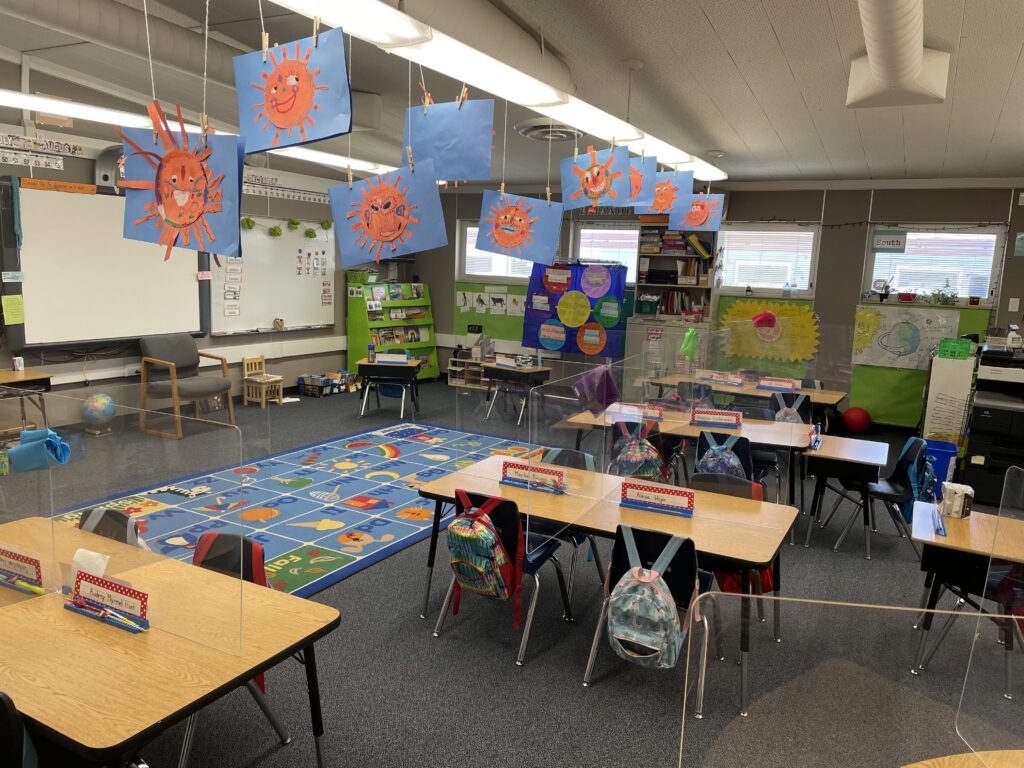
Our classroom tables have plexiglass dividers. We have a few individual desks spread about as well to accommodate our 20 in-person learners while remaining socially distanced.
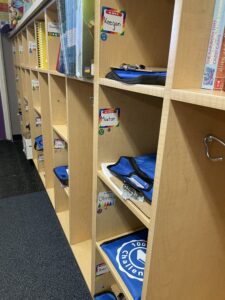
It’s a bit difficult to see, but below each student’s name is a colored sticker, one blue, followed by green, purple, and yellow. This allows us to call students to cubbies to access additional materials, such as clipboards and book bags, while remaining spaced.
Our kids still need to use their cubbies, but there is not room to keep them socially distant if they all go to their cubbies at the same time. Instead, we came up with a plan for how they access the materials or personal items at the back of the room. We labeled the cubbies with colored stickers, so that when a particular color is called, those children can access their items while maintaining distance from others. It sometimes takes a while, but staggering the cubby access has been an important new procedure that we all are working to perfect!
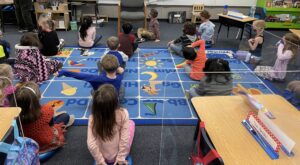
With our 3-feet distance mandate, we are able to fit 9 students at the carpet and the remainder on the perimeter. (We do have a set of twins in class, so they are allowed to sit closer together.)
Moving out extra furniture gave us enough space to still seat children “at the carpet”. This means that we have nine children sitting in a rectangle on the carpet (where we used to seat all 24), and the remaining 11 students are spaced around the perimeter on “wiggle seats”. They still have thinking partners, but we do not touch fingers together to show we are ready to talk this year. Instead, we do old fashioned hand-raising (I should really get more creative about that! Please give suggestions in the comments!). Sometimes it is hard for partners to hear each other speak because they are wearing masks, but one benefit is that partnerships are so spread out that they do not talk over each other. We’re doing our best to find the “wins”! (Side note: Our state mandate is that elementary students must remain 3 feet apart, so I understand that we may have more flexibility that other states.)
We clean tables and plexiglass throughout the day, everyone has their own hand sanitizer, and we wash hands whenever possible, like before eating. The kids have gotten so used to these new routines that they remind us when it is time to clean. I hope you all will remember, kids are resilient! They are amazing! They know the importance of these procedures: so that we can all stay in school and stay healthy.
It turns out I love having a combination of English and Spanish around me when I teach! When doing a Bridge, we can easily reference examples of our contrastive analysis in Spanish, and vice versa. The kids are excited to show me what they are learning during the Spanish part of the day, and the classroom feels more like “theirs” than “mine”. Hmmmm… isn’t that the way it should be? 😊
What are you doing with the physical space in your classroom to accommodate for COVID-compliant protocols while teaching for biliteracy? Please add comments with your thoughts! Come back next week for my reflections on Organization: Planning, Papers, and People.


